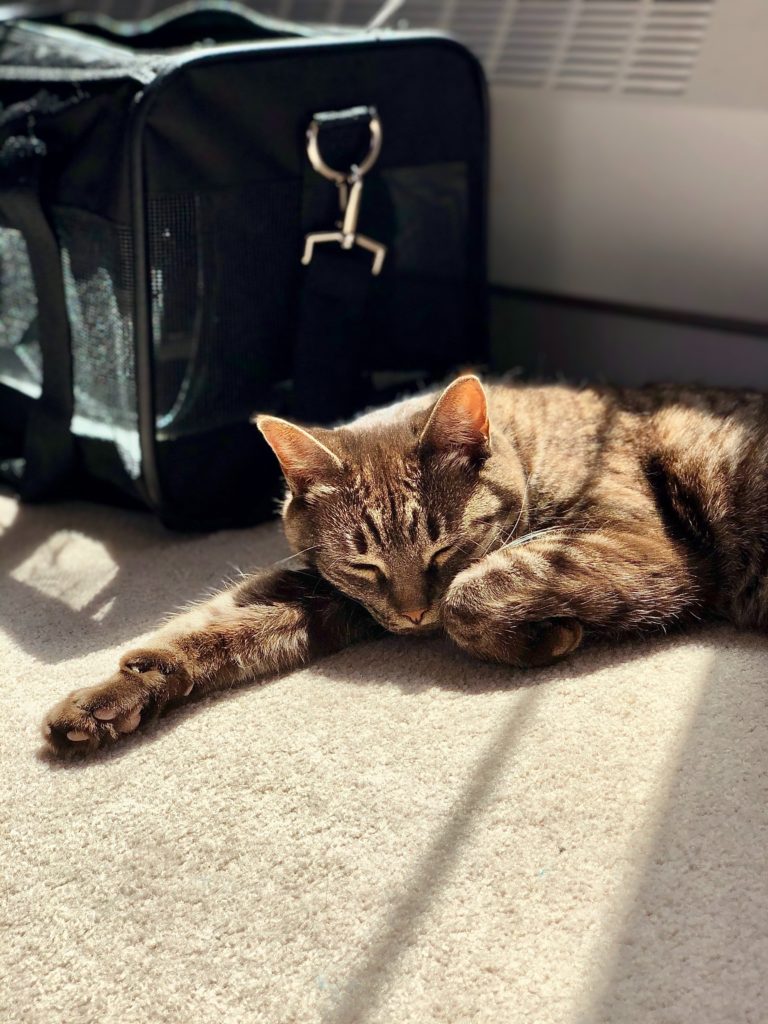Going on vacation? Your companion animal can be a great travel companion on a trip. Preparing to move? Most pets acclimate well to new surroundings with a little bit of time and planning. Here are some tips to help make travel with your pet safer and more fun.
Make sure everyone—including your furry friends—are safely secured while inside of a moving vehicle. There are many harnesses and teethers on the market that can be buckled into your car’s existing restraint system. These help keep dogs from being injured if you have to slam on your brakes or are in an accident. Some pets are more comfortable in a carrier, and be sure to pick out a crate that is suitable for you and your pet. Heavy-duty plastic carriers can be found in various sizes at most pet stores and are safer than folding metal wire crates. Carriers should always be buckled with the seat belt or a specially designed restraint. They can help pets feel calmer and more secure, just be sure to select a crate or carrier that allows your dog or cat to stand up and turn around, but not too big. Too much space inside a crate can lead to injury during sudden stops or accidents. Put a towel or bed inside for a comfy cushion.
If car travel is new for your companion, take him or her for a few short rides to the park or around town before the trip. This will help your dog or cat become comfortable with auto travel. There are also many natural supplements and sprays that can help pets feel calmer while traveling. If your pet shows signs of illness when traveling (vomiting, excessive drooling, heavy panting or shaking) it’s best to see your vet. Vets can prescribe medication that helps pets feel less ill while traveling so that can learn to enjoy the ride.
Food, Water and Exercise
If your dog isn’t accustomed to car travel, do not feed him for 6 – 7 hours before the ride. Stick with your regular diet, giving his main meal at the end of the day’s road trip. Dry food is more convenient, if your pet is used to it. There are also several types of clip-on water holders that can be attached to the inside of carriers to provide water for your furry friend’s trip.
Cats will need a litter box in their carrier. Use only a small amount of litter—they just need to get the scratching sensation.
You can walk the dog when you need a stop on the trip. You and your dog will know how often this needs to be. Older dogs might have to stop more frequently, while other dogs might be able to wait up to 4 hours or more.
Certification and Identification
Carry proof your dog or cat is current on all vaccinations, including rabies. If traveling over state lines, you will need a health certificate from your veterinarian issued within 10 days of traveling. Make sure your dog or cat is micro chipped and has current ID tags with a telephone number where you can be reached—maybe your cell number—secured to his collar. Also carry a photo of your pet to help others identify the animal if he gets lost.
Other Helpful Hints
- Pack your pet’s leash (a leash or harness for cats), food and water bowls, favorite toys, something to chew, a piece of bedding from home and any medication your furry family member requires.
- NEVER let your pet’s head extend outside the car window. Particles of dirt can penetrate the eyes, ears and nose, causing injury or infections. Excess cold air in the lungs can also cause illness.
- Be sure to always park your car in a shaded area to keep the car cool. NEVER leave your pet alone inside a car, even for a few minutes. Find restaurants with drive-through windows or bring someone with you on the trip to take meal shifts so your furry family member can stay in your air-conditioned car.
- Plan ahead where to stop and where to stay. Information on pet-friendly establishments can easily be found in bookstores or online at sites like www.petswelcome.com. Call ahead to confirm their pet policy. Getting your dog or cat ready for travel will be rewarded with many memorable adventures and fun days on the road together.

